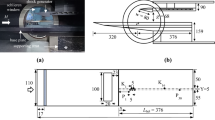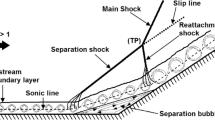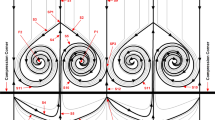Abstract
An experimental study was conducted to control the unsteadiness of separation shock in a Mach 2 24° compression ramp-induced interaction using mechanical vortex generators (VG). Control devices in the form of an array of single-row delta-ramps were placed upstream of the interaction region and tested for two streamwise locations with respect to the boundary layer thickness (δ) at the interaction location and height ‘h’ of the delta-ramps, i.e., at 27.5δ or h/δ = 0.65 and at 12.5δ or h/δ = 0.26, respectively. Surface oil study revealed traces of streamwise counter-rotating vortex pairs generated downstream of these devices. Measurements using pressure-sensitive paint also showed a spanwise sinusoidal pattern of wall pressure variation indicating generation of streamwise vortices from these control devices. These vortices, on interaction with the reverse flow in the separation bubble, replaced a well-defined separation line (for no control) by a highly corrugated separation line. In the region of separation, the mean pressure distribution gets modified while the peak rms value in the intermittent region of separation showed significant changes. Additionally, the spanwise spacing ‘s’ of the vertex of the delta ramps seemed to be an important parameter in controlling the peak rms value. A decrease in this spacing, i.e., VG1 with s = 0, significantly reduced the peak rms value (by 50 and 35 %) while an increase in the spacing, i.e., VG2 with s = 1 mm, consistently showed an increase (by 12 and 30 %) in the separation shock unsteadiness relative to no control, irrespective of their placement location (of h/δ = 0.65 and 0.26, respectively).
Similar content being viewed by others
Abbreviations
- s :
-
Spacing in the vertex of the vortex generating delta ramps (mm)
- h :
-
Maximum height of the delta ramp (mm)
- δ :
-
Boundary-layer thickness (mm)
- G(f):
-
Power spectral density (kPa2/Hz)
- M ∞ :
-
Freestream Mach number
- P 0 :
-
Pressure in the stagnation chamber of the wind tunnel (kPa)
- P ∞ :
-
Freestream static pressure (kPa)
- P w :
-
Local wall pressure (kPa)
- σ :
-
rms of the local wall pressure
- t :
-
Time at a particular sequence of event (s)
- X :
-
Co-ordinate along the streamwise direction (mm)
- T 0 :
-
Stagnation temperature (K)
References
Kistler A.L.: Fluctuating wall pressure under separated supersonic flow. J. Acoust. Soc. Am. 36, 543–550 (1964)
Hadjadj A., Dussauge J.P.: Shock wave boundary layer interaction. Shock Waves 19, 449–452 (2009)
Dolling D.S., Murphy M.T.: Unsteadiness of the separation shock wave structure in a supersonic compression ramp flowfield. AIAA J. 21(12), 1628–1634 (1983)
Muck K.C., Andreopoulos J., Dussuage J.P.: Unsteady nature of shock-wave/boundary-layer interactions. AIAA J. 26(2), 179–187 (1988)
Verma S.B.: Experimental study of flow unsteadiness in a Mach 9 compression ramp interaction using a laser schlieren system. Meas. Sci. Technol. J. 14, 989–997 (2003)
Dolling, D.S., Bogdonoff, S.M.: An Experimental Investigation of the Unsteady Behavior of Blunt Fin-Induced Shock Wave Turbulent Boundary Layer Interaction. AIAA Paper 81-1287
Dolling D.S., Brusniak L.: Separation shock motion in fin, cylinder, and compression ramp-induced turbulent interactions. AIAA J. 27(6), 734–742 (1989)
Maull D.J.: Hypersonic flow over axially symmetric spiked bodies. J. Fluid Mech. 4, 584–592 (1960)
Charwat A.F., Dewey C.F., Roos J.N., Hitz J.A.: Investigation of separated flows, part II; flow in cavity and heat transfer. J. Aeronaut. Sci. 28(7), 513–527 (1961)
Dolling D.S.: Fifty years of shock-wave/boundary-layer interaction research: what next?. AIAA J. 39(8), 1517–1531 (2001)
McCormick, D.C.: Shock-Boundary layer interaction control with low-profile vortex generators (SBVGs) and passive cavity. AIAA Paper 92-0064
Souverein L.J., Debiève J.-F: Effect of air jet vortex generators on a shock wave boundary layer interaction. Exp. Fluids 49, 1053–1064 (2010)
Babinsky, H., Makinson, N.J., Morgan, N.J.: Micro-vortex Generator Flow Control for Supersonic Engine Inlets. AIAA Paper 2007-0521
Szwabe R.: Shock wave induced separation control by streamwise vortices. J. Therm. Sci. 14(3), 249–253 (2005)
Blinde P.L., Humble R.A., Oudheusden B.W., Scarano F.: Effects of micro-ramps on a shock wave/turbulent boundary layer interaction. Shock Waves 19(6), 507–520 (2009)
Bur R., Coponet D., Carpels Y.: Separation control by vortex generators devices in a transonic channel flow. Shock Waves 19(6), 521–530 (2009)
Lin J.C.: Review of research on low-profile vortex generators to control boundary-layer separation. Prog. Aerosp. Sci. 38(4–5), 389–420 (2002)
McCormick D.C.: Shock/boundary-layer interaction control with vortex generators and passive cavity. AIAA J. 31(1), 91–96 (1993)
Barter J.W., Dolling D.S.: Reduction of fluctuating pressure loads in shock/boundary-layer interactions using vortex generators. AIAA J. 33(10), 1842–1849 (1995)
Vishwanath P.R.: Shock-wave turbulent boundary-layer interaction and its control; a survey of recent developments. Sadhana 12, 45–104 (1988)
Raju C., Vishwanath P.R.: Pressure-sensitive paint measurements in a blow-down wind tunnel. J. Aircr. 42(4), 908–915 (2005)
Lawrence S.U., Michael K.P., John M.S., Bernard J.: Suppression of pressure loads in cavity flows. AIAA J. 42(1), 70–79 (2004)
Ganapathisubramani B., Clemens N.T., Dolling D.S.: Large-scale motions in a supersonic turbulent boundary layer. J. Fluid Mech. 556, 271–282 (2006)
Masaru K., Kyuro S.: Structure of a turbulent separation bubble. J. Fluid Mech. 137, 83–113 (1983)
Garg, S., Settles, G.S.: Unsteady pressure loads generated by swept-shock-wave/boundary-layer interactions. AIAA J. 34(6) (1996)
Berry S.A., Auslender A.H., Dilley A.D., Calleja J.F.: Hypersonic boundary-layer trip development for hyper-x. J. Spacecr. Rockets 38(6), 853–864 (2001)
Author information
Authors and Affiliations
Corresponding author
Additional information
Communicated by A. Hadjadj.
Rights and permissions
About this article
Cite this article
Verma, S.B., Manisankar, C. & Raju, C. Control of shock unsteadiness in shock boundary-layer interaction on a compression corner using mechanical vortex generators. Shock Waves 22, 327–339 (2012). https://doi.org/10.1007/s00193-012-0369-8
Received:
Revised:
Accepted:
Published:
Issue Date:
DOI: https://doi.org/10.1007/s00193-012-0369-8




